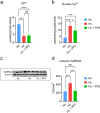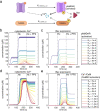Computational analysis of cortical neuronal excitotoxicity in a large animal model of neonatal brain injury
- PMID: 35351004
- PMCID: PMC8966144
- DOI: 10.1186/s11689-022-09431-3
Computational analysis of cortical neuronal excitotoxicity in a large animal model of neonatal brain injury
Abstract
Background: Neonatal hypoxic brain injury is a major cause of intellectual and developmental disability. Hypoxia causes neuronal dysfunction and death in the developing cerebral cortex due to excitotoxic Ca2+-influx. In the translational piglet model of hypoxic encephalopathy, we have previously shown that hypoxia overactivates Ca2+/Calmodulin (CaM) signaling via Sarcoma (Src) kinase in cortical neurons, resulting in overexpression of proapoptotic genes. However, identifying the exact relationship between alterations in neuronal Ca2+-influx, molecular determinants of cell death, and the degree of hypoxia in a dynamic system represents a significant challenge.
Methods: We used experimental and computational methods to identify molecular events critical to the onset of excitotoxicity-induced apoptosis in the cerebral cortex of newborn piglets. We used 2-3-day-old piglets (normoxic [Nx], hypoxic [Hx], and hypoxic + Src-inhibitor-treatment [Hx+PP2] groups) for biochemical analysis of ATP production, Ca2+-influx, and Ca2+/CaM-dependent protein kinase kinase 2 (CaMKK2) expression. We then used SimBiology to build a computational model of the Ca2+/CaM-Src-kinase signaling cascade, simulating Nx, Hx, and Hx+PP2 conditions. To evaluate our model, we used Sobol variance decomposition, multiparametric global sensitivity analysis, and parameter scanning.
Results: Our model captures important molecular trends caused by hypoxia in the piglet brain. Incorporating the action of Src kinase inhibitor PP2 further validated our model and enabled predictive analysis of the effect of hypoxia on CaMKK2. We determined the impact of a feedback loop related to Src phosphorylation of NMDA receptors and activation kinetics of CaMKII. We also identified distinct modes of signaling wherein Ca2+ level alterations following Src kinase inhibition may not be a linear predictor of changes in Bax expression. Importantly, our model indicates that while pharmacological pre-treatment significantly reduces the onset of abnormal Ca2+-influx, there exists a window of intervention after hypoxia during which targeted modulation of Src-NMDAR interaction kinetics in combination with PP2 administration can reduce Ca2+-influx and Bax expression to similar levels as pre-treatment.
Conclusions: Our model identifies new dynamics of critical components in the Ca2+/CaM-Src signaling pathway leading to neuronal injury and provides a feasible framework for drug efficacy studies in translational models of neonatal brain injury for the prevention of intellectual and developmental disabilities.
Keywords: Calcium/calmodulin; Computational modeling; Excitotoxicity; Neonatal brain injury; Nuclear calcium; SimBiology; Src kinase.
© 2022. The Author(s).
Conflict of interest statement
The authors declare that they have no competing interests.
Figures







Similar articles
-
Nuclear Ca(++)-influx, Ca (++)/calmodulin-dependent protein kinase IV activity and CREB protein phosphorylation during post-hypoxic reoxygenation in neuronal nuclei of newborn piglets: the role of nitric oxide.Neurochem Res. 2006 Dec;31(12):1463-71. doi: 10.1007/s11064-006-9204-x. Epub 2006 Nov 8. Neurochem Res. 2006. PMID: 17091402
-
Mechanism of CaM kinase IV activation during hypoxia in neuronal nuclei of the cerebral cortex of newborn piglets: the role of Src kinase.Neurochem Res. 2011 Aug;36(8):1512-9. doi: 10.1007/s11064-011-0477-3. Epub 2011 Apr 23. Neurochem Res. 2011. PMID: 21516343
-
Brain tissue energy dependence of CaM kinase IV cascade activation during hypoxia in the cerebral cortex of newborn piglets.Neurosci Lett. 2011 Mar 17;491(2):113-7. doi: 10.1016/j.neulet.2011.01.017. Epub 2011 Jan 12. Neurosci Lett. 2011. PMID: 21236315 Free PMC article.
-
Molecular mediators of hypoxic-ischemic injury and implications for epilepsy in the developing brain.Epilepsy Behav. 2005 Sep;7(2):204-13. doi: 10.1016/j.yebeh.2005.05.015. Epilepsy Behav. 2005. PMID: 16054439 Review.
-
Superoxide and Non-ionotropic Signaling in Neuronal Excitotoxicity.Front Neurosci. 2020 Sep 3;4:861. doi: 10.3389/fnins.2020.00861. eCollection 2020. Front Neurosci. 2020. PMID: 33013314 Free PMC article. Review.
Cited by
-
Systems-level computational modeling in ischemic stroke: from cells to patients.Front Physiol. 2024 Jul 2;15:1394740. doi: 10.3389/fphys.2024.1394740. eCollection 2024. Front Physiol. 2024. PMID: 39015225 Free PMC article. Review.
-
Hypoxia Modulates Sodium Chloride Co-transporter via CaMKII-β Pathway: An In Vitro Study with mDCT15 Cells.Life (Basel). 2024 Sep 25;14(10):1229. doi: 10.3390/life14101229. Life (Basel). 2024. PMID: 39459529 Free PMC article.
-
Neuroprotective effect of Src kinase in hypoxia-ischemia: A systematic review.Front Neurosci. 2022 Nov 24;16:1049655. doi: 10.3389/fnins.2022.1049655. eCollection 2022. Front Neurosci. 2022. PMID: 36507364 Free PMC article.
-
Differential Effects of Hypothermia and SZR72 on Cerebral Kynurenine and Kynurenic Acid in a Piglet Model of Hypoxic-Ischemic Encephalopathy.Int J Mol Sci. 2023 Sep 25;24(19):14522. doi: 10.3390/ijms241914522. Int J Mol Sci. 2023. PMID: 37833970 Free PMC article.
-
Mechanism of Gynostemmae Pentaphylli Herba in the treatment of ischemic stroke based on network pharmacology and molecular docking.Am J Transl Res. 2023 Jun 15;15(6):4079-4089. eCollection 2023. Am J Transl Res. 2023. PMID: 37434834 Free PMC article.
References
-
- Burd I, Welling J, Kannan G, Johnston M, v. Excitotoxicity as a common mechanism for fetal neuronal injury with hypoxia and intrauterine inflammation. Adv Pharmacol. 2016;76:85–101. - PubMed
-
- Lawn JE, Cousens S, Zupan J. 4 million neonatal deaths: When? Where? Why? Lancet. 2005;365:891–900. - PubMed
-
- Rossi DJ, Oshima T, Attwell D. Glutamate release in severe brain ischaemia is mainly by reversed uptake. Nature. 2000;403(6767):316–321. - PubMed
Publication types
MeSH terms
Substances
Grants and funding
LinkOut - more resources
Full Text Sources
Research Materials
Miscellaneous

